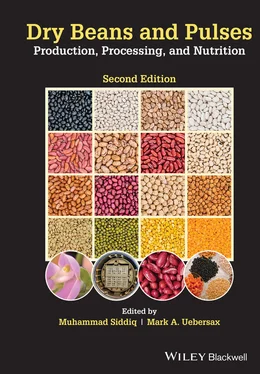1 ...6 7 8 10 11 12 ...46 Among pulses, India ranked first in chickpea production with 9,937,990 MT, or about 70% of total world production in 2019. Turkey, Russian Federation, Myanmar, and Pakistan were the other countries in the top‐five chickpea producers. Lentil production is led by Canada (2,166,900 MT) followed by India, Australia, Turkey, and Nepal. Canada’s share of total lentil production in the world was nearly 38%. Australia was the top producer of lupins , with a 47% share of total world production, followed by Russian Federation, Poland, Morocco, and Chile; these five countries accounted for 89% of lupins produced in 2019. India, Malawi, Myanmar, Tanzania, Kenya were the top‐five pigeonpea producing countries, with India alone producing about 75% pigeonpeas. Ethiopia, with 41% of total world production, was the top producer of vetches in 2019, while India led in the production of other minor pulses with 20% global share.
Among all pulse crops, only dry beans, chickpeas, and lentils are traded globally on a wider scale (FAO 2020). Cowpeas and other pulses are traded in the world market on a much smaller basis but FAO does not report data on these pulse crops. The major exporting and importing countries for dry beans, chickpeas, and lentils are listed in Table 1.3 . Myanmar, Russian Federation, and Canada were the top exporters of dry beans, chickpeas, and lentils in 2019, with 23.92, 21.61, and 54.28% share of total exports, respectively. Other countries among top‐five exporters were Argentina, USA, China, and Canada (dry beans), Australia, Turkey, USA, and Mexico (chickpeas), and Australia, Turkey, USA, and UAE (lentils). The top‐five importing countries were India, Brazil, Turkey, USA, and China (dry beans), Egypt, Pakistan, India, Bangladesh, and Turkey (chickpeas), and India, Bangladesh, Turkey, UAE, and Sri Lanka (lentils). It is noted that UAE, which is not a major producer of chickpeas and lentils, imports these quantities in bulk and exports them in bulk and retail size packaging.
Table 1.3. Leading dry beans, chickpeas, and lentils exporting and importing countries in 2019 (metric tons).
Source: FAO (2020).
| Exporters: |
| Dry beans |
Chickpeas |
Lentils |
| Myanmar |
1,097,218 |
Russian Fed. |
470,439 |
Canada |
2,116,910 |
| Argentina |
457,041 |
Australia |
406,157 |
Australia |
498,992 |
| USA |
451,733 |
Turkey |
212,598 |
Turkey |
308,545 |
| China |
350,649 |
USA |
154,784 |
USA |
262,404 |
| Canada |
342,563 |
Mexico |
133,309 |
UAE |
209,780 |
| Uganda |
175,000 |
Canada |
129,922 |
Kazakhstan |
181,809 |
| Ethiopia |
165,265 |
India |
123,493 |
Russian Fed. |
150,818 |
| Mozambique |
164,055 |
Tanzania |
111,459 |
Syria |
19,678 |
| Uzbekistan |
151,077 |
Argentina |
103,928 |
Egypt |
17,401 |
| Brazil |
123,106 |
UAE |
61,830 |
India |
17,338 |
| World Total 1 |
4,587,193 |
World Total 1 |
2,177,431 |
World Total 1 |
3,899,913 |
| Importers: |
| Dry Beans |
Chickpeas |
Lentils |
| India |
520,965 |
Egypt |
5,672,922 |
India |
822,398 |
| Brazil |
150,660 |
Pakistan |
410,083 |
Bangladesh |
472,411 |
| Turkey |
145,240 |
India |
371,883 |
Turkey |
401,168 |
| USA |
139,850 |
Bangladesh |
241,076 |
UAE |
268,139 |
| China |
134,956 |
Turkey |
114,770 |
Sri Lanka |
167,810 |
| Italy |
131,527 |
UAE |
105,076 |
Pakistan |
123,735 |
| Mexico |
123,653 |
Iraq |
77,083 |
Iraq |
100,059 |
| UK |
116,543 |
Algeria |
75,377 |
Colombia |
86,475 |
| Pakistan |
103,871 |
Saudi Arabia |
60,786 |
Canada |
83,154 |
| Viet Nam |
94,559 |
Spain |
56,979 |
Sudan |
79,353 |
| World Total 1 |
3,453,050 |
World Total 1 |
7,796,178 |
World Total 1 |
3,770,132 |
1 Including all other countries not listed
The total US production of dry beans was 1.78 million MT in 2020. North Dakota, Michigan, and Minnesota were the three leading dry beans–producing states in 2020 ( Table 1.4 ); together, these three states represented about 76% of total US production, with 41.62%, 17.27%, and 16.69% share, respectively. Michigan was once the leading dry beans–producing state; however, North Dakota has now been the leader for over two decades. Since 1990, Minnesota and North Dakota have recorded significant increases of 230.26% and 190.90%, respectively. Five states have shown a decrease in dry beans production since 1990, with percent decrease shown in parenthesis: California (79.59%), Colorado (74.48%), Idaho (53.20%), Wyoming (33.99%), and Nebraska (30.32%).
Table 1.4. Leading dry beans producing states in the US for selected years since 1990 (metric tons).
Source: USDA‐ERS (2011), USDA‐ERS (2020a).
| State 1 |
1990 |
2000 |
2010 |
2020 |
% Change (1990–2020) |
| North Dakota |
254,270 |
386,765 |
521,500 |
739,683 |
+190.90 |
| Michigan |
276,623 |
209,563 |
192,273 |
306,847 |
+10.93 |
| Minnesota |
89,820 |
121,928 |
139,182 |
296,635 |
+230.26 |
| Nebraska |
254,219 |
163,586 |
145,136 |
177,148 |
−30.32 |
| Idaho |
180,859 |
87,178 |
115,727 |
84,637 |
−53.20 |
| Colorado |
217,184 |
100,590 |
57,000 |
55,425 |
−74.48 |
| Washington |
46,333 |
32,514 |
62,545 |
52,835 |
+14.03 |
| Wyoming |
49,025 |
38,712 |
46,545 |
32,361 |
−33.99 |
| California |
155,356 |
104,604 |
66,455 |
31,701 |
−79.59 |
| Other states |
121,267 |
102,521 |
99,136 |
nr 2 |
‐‐ |
| Total (U.S.) |
1,644,956 |
1,347,961 |
1,445,499 |
1,777,272 |
+8.04 |
1 Ranked by 2020 production data
2 Not reported (USDA stopped reporting data since 2019 for Montana and Texas, which comprised other states)
Lucier and Davis (2020) reported that the US imported dry beans from 69 countries and the top‐five countries reported by the Department of Commerce include Canada, Mexico, Nicaragua, China, and India, which together represented 72% of all US dry bean imports. The most predominant dry bean classes imported in the 2019–2020 season were mung beans (23%), kidney beans − dark red, light red, and other kidney beans (19%), black beans (12%), and pinto beans (9%). Mung beans in the United States are mostly used for bean sprouts in salads or used in soup mixes and bean flour. US dry bean exports overall are down by 4% in 2020, which continued a downward trend in recent years.
Читать дальше












